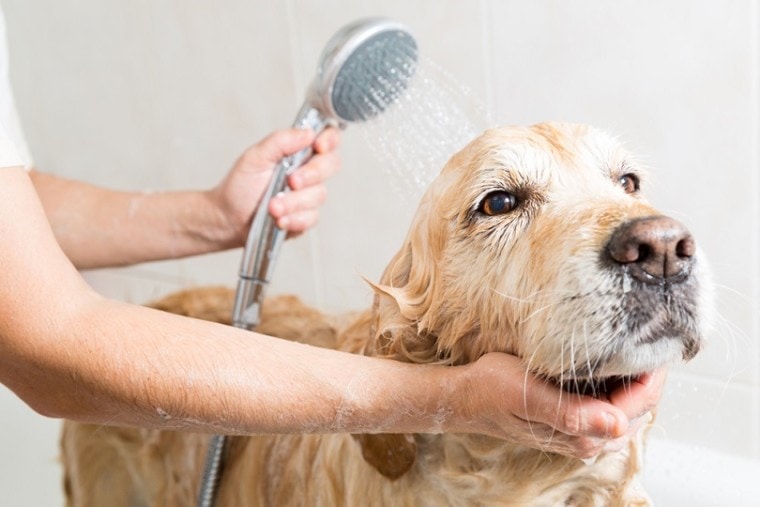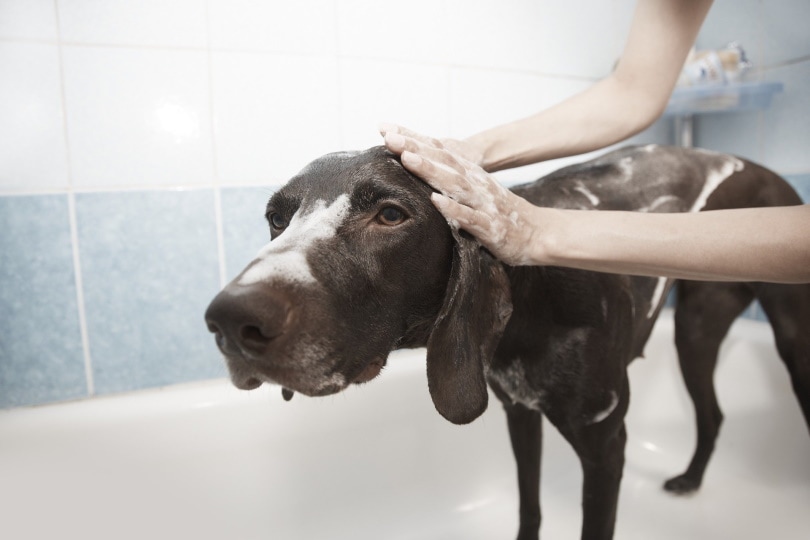
Click to Skip Ahead
Dogs are not well known for their love of bath time. Howling, crying, and puppy dog eyes are a well-documented response by owners and dog groomers alike. Is there a reason that dogs hate baths? Can we better understand them to help them like baths? Here are four reasons your dog might find bath time to be stressful.
The 4 Reasons Dogs Hate Baths
1. They Hate the Noise
Dogs have sensitive hearing, so the sound of running water right next to their head might be scary for them. Especially if they’re a breed that doesn’t get groomed too often, they might not have had the time as a puppy to get used to the sounds of bath time that many dogs get.
The noise could bother their hearing especially if they’re a breed that doesn’t get bathed often. Most dogs only need to be cleaned about once a month unless they start to smell, and overbathing is a real problem dogs can face, so dogs don’t always get desensitized to the sound of the bath.

2. It’s Unfamiliar to Them
Dogs, like people, get anxious in unfamiliar situations. If a dog isn’t used to being bathed or isn’t used to the grooming salon, they might become upset during baths until they learn that the situation is safe for them.
If your dog is usually banned from the bathroom, you’ve recently moved, or they’re a young puppy, they might be uncomfortable because the situation is new and scary.
3. They Don’t Like Not Being in Control
Dogs also don’t like being out of control. Most creatures, dogs included, don’t want to feel like they’re at the mercy of someone else and bath time is a time when your dog isn’t in control, especially if they go to a dog groomer.
Groomers will often restrain the dogs in their care for the safety of the dog and the groomer alike. Even owners usually don’t allow their dogs to tap out of a bath, and this yielding of control can be scary for dogs.

4. You Find Bath Time Stressful
Dogs also feed off their owners’ emotions. Your dog knows when you’re feeling anxious, and it makes them feel anxious too. If you find yourself dreading bath time, it’s no wonder your dog also finds itself feeling nervous and excitable.
Staying calm shows your dog that they can be calm too. It can be hard to keep quiet when you know your dog hates baths but remember that the water doesn’t hurt them! Just like a kid, they need to be cleaned, and getting upset will only make them think they’re in danger.
The 3 Tips to Help Your Dog Learn to Love Baths
Unfortunately, dogs can’t go entirely without baths. They don’t have the same kind of self-grooming abilities as cats and need our help to maintain good health and cleanliness. So, what can we do to make our dogs more comfortable with being bathed?
1. Stay Cool
Staying relaxed will help your dog stay calm too. Dogs rely on pack tactics to know what they should and shouldn’t be afraid of. If you seem scared of bath time, your dog will take that to mean that they should be scared too.
Staying calm is easier said than done but taking deep breaths and reminding your dog that everything will be okay can help them feel safe during bath time.

2. Create Positive Associations
You’ll want your dog to associate bath time and the environment it takes place in with positive memories. Placing your dog’s food bowl in the bathroom with a trail of treats leading up to it can help your dog create positive associations with the bath environment.
If the only time your dog gets to be in the bathroom is when they’re getting bathed, they’ll start to hate being in the bathroom at all. So, making sure that your dog has positive associations with the bathroom will help them stay calm and feel safe when it comes time for a bath.
You don’t want to try bathing them right away. You want to give them time to create a positive connection between the bath and food first. Then try getting them into the bathtub. Let them get in by themselves if they’re large enough and let them get back out if they’re afraid.
Once they can get in and stay in the tub without fear, it’s time to turn on the water. Don’t fill the tub and bathe them just yet. Give them some toys and try to create positive memories by playing with the water. You can even smear some peanut butter off the wall and let them lick it off while the water runs.
Finally, when they’re able to tolerate the sound of running water and getting their feet wet, you’ll want to start splashing some water onto their fur. It’s not time for a full-on bath, but it’s essential to show them that they can have fun in the tub by playing with the water.
You can start bathing your dog regularly after you’ve created enough positive associations that they begin to enjoy being in the bath.
3. Avoid Negative Associations
Never force your dog into the tub unless it’s an emergency and they need to be bathed immediately. Put down a non-slip mat or non-slip stickers so that your dog doesn’t feel unsteady and consider getting a bathing harness like groomers use to help your dog feel safe and secure in the bathtub.
Keep the water temperature in mind and try to keep it comfortable for them, not too hot or too cold. Avoid splashing water directly into the dog’s face or any other sensitive areas.
Taking these precautions will help you and your dog feel more comfortable when approaching bath time!

Conclusion
Though dogs often dislike baths, there’s no reason that that must be the only way! It’s possible to help your dog learn to enjoy bath time and cause more minor problems for you and your groomer. Getting your dog more comfortable with being bathed can seem like an uphill battle, but it will benefit both you and your pup in the long run.
Next on your reading list:
Featured Image Credit: 135pixels, Shutterstock







